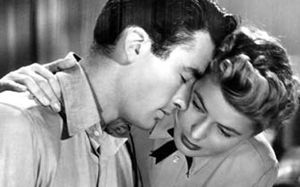 A man takes scissors to a surrealistic curtain, cutting an eyeball in half. Another man runs across a terrible angular landscape, stalked by a gigantic bird. A faceless tyrant lets slip a warped wheel as the camera slithers into the void of its center hole.
A man takes scissors to a surrealistic curtain, cutting an eyeball in half. Another man runs across a terrible angular landscape, stalked by a gigantic bird. A faceless tyrant lets slip a warped wheel as the camera slithers into the void of its center hole.
Just another day at the office for Salvador Dali, mad genius and painter of the unreal. The above nightmare, “ordered by telephone” for Mr. Alfred Hitchcock, serves, of course, as the centerpiece of the 1945 psychotherapy thriller “Spellbound.” The sequence is considered a classic collaboration between two giants of the visual arts — quite a stretch, as it turns out.
The dream sequence and its twisted history get a close examination as MGM/Fox Home Entertainment debuts “Spellbound” on Blu-ray.
Also making their HD bows are “Rebecca” and “Notorious,” two other Hitchcock films done for producer David O. Selznick.
Extra features on the Fox Blu-rays have minor overlaps with the Criterion DVDs of these films from 2001 and 2002, but for the most part the bonus features are original. (This Blu-ray review of “Spellbound” makes use of material from the Fox and Criterion releases.)
Fox’s new black-and-white “Spellbound” is presented in the original full-screen aspect ratio (1.33:1). Images come with a healthy serving of grain, and in some cases the processing makes itself obvious, with jagged edges on clothing and such. Overall, it’s a handsome presentation but one that makes no bell-ringing improvements over the (carefully rendered) Criterion DVD.
The DTS-HD Master Audio mono reproduction on the Blu-ray is reasonably strong, although some home theater set-ups will route the signal solely to the center front speaker. (Change the audio processing option on your receiver to fix this.) The score includes Miklos Rozsa’s terrific “Overture” and “Exit” music, long lost and first resurrected on Criterion’s version.
While Hitchcock dismissed “Spellbound” as a minor work “wrapped in pseudo-psychoanalysis,” some contributors to the Blu-ray make the case that the film is essential to understanding Hitchcock’s art. Excellent performances from Ingrid Bergman (a virginal psychiatrist) and heartthrob Gregory Peck (a mysterious murder suspect) make the movie more than just an offbeat warm-up for 1946’s masterpiece, “Notorious.”
Hitchcock and Dali found their twisted intentions for the dream sequence thwarted by budget concerns and the hands-on involvement of Selznick. Hitchcock wanted to shoot the scenes outdoors for “great visual sharpness”; Selznick found the cost “absurd” and ordered the work onto stages.
Dali and Hitchcock envisioned a scene with pianos hanging from the ceiling and ballroom dancers below; Selznick demanded the use of miniature pianos and “little people” to fix the perspective.
 Arguments between the director and producer, two prototypical control freaks, “left little time for work,” star Bergman recalled. One of the sequences cut from the dream sequence had insects crawling out of a plater cast made of the actress — a nod no doubt to “Un Chien Andalou,” the surrealist manifesto on which Dali was a co-conspirator.
Arguments between the director and producer, two prototypical control freaks, “left little time for work,” star Bergman recalled. One of the sequences cut from the dream sequence had insects crawling out of a plater cast made of the actress — a nod no doubt to “Un Chien Andalou,” the surrealist manifesto on which Dali was a co-conspirator.
The 20-minute “Dreaming With Scissors” docu tells how Dali was brought aboard to “increase the seriousness of the project” — and to give the promo boys plenty to work with. Dali was still cutting edge at the time. The artist’s brother died as an infant and the project had “a powerful psychosis” for the artist, the docu says.
In the end, Selznick found the dream sequence a “severe disappointment” that was “completely lacking in imagination — ordering endless reshoots and bringing in director William Cameron Menzies to fix the problem. Hitchcock was reduced to approving storyboards. The successful team of Hitchcock and Selznick had run its course — they would make only one more film together.
Selznick’s micromanagement was typical, but his interest in psychotherapy was keen. He’d just suffered the death of his brother and was in analysis himself, perhaps heightening his urge to control the dream sequence. He even brought his own analyst into the fray. Writer Ben Hecht also was in analysis.
The Fox featurette “Guilt by Association” notes that this was one of the first films to address psychoanalysis. Ironically, “It is not as complicated psychologically and psycho-sexually as a lot of other Hitchcock films,” says film historian Tom Schatz. “Psychotherapy bores me,” one character says early on — and the abundance of explanatory material may well leave some in the Blu-ray audience feeling the same way.
“Guilt” also ties the film’s central mystery to the return of WWII veterans, many suffering what we call post-traumatic stress.
Schatz does the feature-length commentary with fellow film professor Charles Ramirez Berg. They’re good company but the academics are mostly reactive to what’s going on onscreen. For some reason they spend a lot of time pointing out what audiences know and when they know it. Despite the groundbreaking use of the theramin, they say, Selznick still draped the film in his favored “big music.”
(For Criterion, Hitchcock historian Marian Keane did the commentary. Keane has the tone of an academic — all business — while obviously reading a script. The grad school lecture tone takes some getting used to, but it’s worth the effort.
“The world of ‘Spellbound’ is the world of a Hitchcock film,” Keane says. “A world accurately aware that a camera is viewing it and an audience is viewing it, too. The only way out of a Hitchcock film is to leave the view of the camera — escape it.”)
Both the Fox and Criterion discs include a 1948 radio adaptation of the film script starring Joseph Cotton.
The Fox disc also includes a piece on actress Rhonda Fleming, who appeared in her first real film role as an oversexed mental patient. She recalls Bergman and Hitchcock with affection. Selznick, she recalls, had an overpowering presence. Elsewhere, she talks about having her beautiful designer gown cut to shreds while wearing it for the “Spellbound” dream sequence.
The Criterion DVD includes an interesting public radio piece on the Theremin. The Oscar-winning score is discussed by composer Rozsa in a 1973 audio interview that’s interesting but difficult to understand at times.
Check out Glenn Abel on Google+



Dear Glenn,
This is a very good essay, by my lights, and I appreciate that you listened to my (overly academic) commentary on the film, which I found then, and find now, to repudiate interpretation almost as a matter of course — while referencing Freud, and psychoanalytic method, all the time. The film is a stymie! A closed book, in so many ways. One has to search for vulnerabilities in this film.
At first, I didn’t want to write about “Spellbound,” when I was asked to do so. So many Hitchcock films to discuss and enjoy — and discuss and find difficult, but more romantic, or vulnerable. When I took “Spellbound” on, for an essay–a shot-by-shot essay — I took on thinking about the limits Hitchcock placed on interpretation of his work at that time. Thanks for your words about this complicated film. You are very good at what you do. (Marian Keane)
Thanks for the classy comments, Marian. “A closed book, in many ways.” How true.